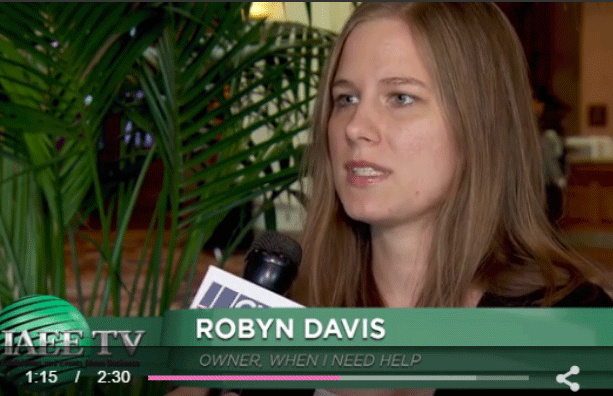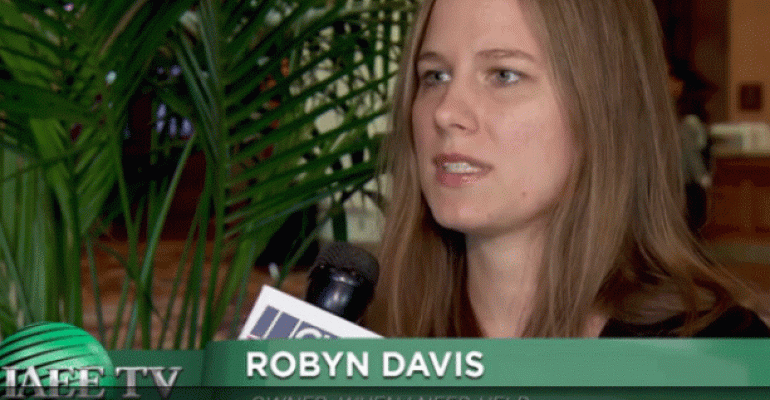 Today's guest post is by Trade Show Strategy Specialist Robyn Davis.
Today's guest post is by Trade Show Strategy Specialist Robyn Davis.
What do associations need to do to support their exhibitors and, ultimately, encourage them to return year after year? Generally speaking, you have to:
• Set yourself apart from other competing organizations/activities (by becoming the best version of yourself)
• Respect your exhibitors as the awesome professionals they are
• Help them get more value out of their investment in participating in your event
So how, specifically, can you do all that? Here are eight suggestions I shared during an interview with CNTV on behalf of IAEE-TV:
1. Add Value During "Off Hours"
Motivated exhibitors will find a way to fill as much of their schedules as possible, but a few gaps may remain in between offical event activities. Organize alternative activities (like relevant training opposite educational sessions for attendees or bonus networking time after setup ends, but before the conference officially begins) as an option for exhibitors who want to go above and beyond.
Why? For exhibitors, time is literally money at trade shows—they’ve invested in the opportunity to participate and they’ve had to put a hold on their typical money-making activities while away. Even short bursts of wasted time weigh on exhibitors heavily and, in many cases, cloud their opinion of your event overall.
2. Set a Good Example
The golden rule (treat others as you wish to be treated) certainly applies to trade shows! Keep this in mind as you set your expectations for exhibitors:
• If you want exhibitors to participate on social media, set a good example by getting the conversation started and mentioning them personally.
• If you want exhibitors to prioritize the deadlines you’ve set and read your communications, make sure that you’re reading their messages and responding to their requests in a timely manner as well.
Why? It's easier for exhibitors to follow your positive example than to try and set their own—it’s your show, after all. Also, once you’ve made an effort to treat them with respect, exhibitors will feel obligated to return the courtesy.
3. Walk a Mile in their Shoes
When possible, spend time on your show floor, blending in as much as you can to experience your event as your exhibitors do. Or, if you can't immerse yourself in your exhibitor’s environment at your own trade show, seek out opportunities to attend the events they attend. Get to know them as people and listen attentively to their stories. Work to understand what they go through on a day-to-day basis and what they want, not just from your event, but from their work and life too.
Why? Without experiencing an exhibitor’s challenges (and triumphs) first hand, it may be difficult to understand their reactions or anticipate which accommodations will be mean the most to them (and which ones won’t). Many conflicts can be avoided with a little extra empathy, and many hearts can be won the same way.
4. Be Transparent
Especially for new exhibitors, the policies and requirements of a trade show can be a bit of a mystery. Look for opportunities earlier in your interactions with exhibitors to share the reasoning for your decisions (especially surrounding any seemingly unfriendly policy updates) and provide “sneak peeks” at the little things you’re working on for them (from introducing the staff member who answers their emails to demonstrating how you assemble all of the materials they'll pick up at registration, etc.).
Why? Exhibitors are reasonable people. Once they can see that there’s a good reason for any inconveniences they encounter (or at least that you are a real person, who is doing your best to support them), they’ll be more understanding of the situation, even if it’s challenging, and happier to work within the guidelines presented.
5. Encourage Collaboration
Point out opportunities for exhibitors to get to know one another (perhaps even during their “off hours,” as I suggested earlier) or, better yet, organize a special mixer or extra exhibit hall hours that are dedicated exclusively to partnering. To make this time as effective as possible for exhibitors, teach them to focus on connecting with the other exhibitors who serve the same segment of your audience but aren’t in direct competition with them (then, they can recommend one another to outside contacts or make appropriate introductions during/after the event).
Why? Although exhibitors come to your events to meet qualified attendees, they can also benefit from the expertise of each other, as well as more concrete joint efforts in support of their common goals. Realizing this opportunity exists can be game changing for individual exhibitors and, on a larger scale, when they take advantage of the opportunities, your industry as a whole will flourish.
6. Pursue Collaboration
Just as your exhibitors can benefit from the right partnerships, so can you. Use your understanding of your own strengths and weaknesses, and your exhibitors’ needs and goals to identify other individuals or organizations that can complement your efforts. Don't be shy in approaching the professionals your exhibitors need you to know! Do your homework and present your proposal confidently, finding an opportunity that benefits each party in a meaningful way.
Why? Many associations are strapped for time and cash, so it makes sense that 81 percent outsource to other service providers when they need “special skills” instead of trying to obtain that expertise for themselves. You too can do this to improve the experience your exhibitors enjoy and the value you’ve equipped them to obtain.
7. Listen
When you ask for feedback from your exhibitors, what do you do with the information they provide? Show exhibitors that you hear them by responding personally, in a timely manner, and use the input they provide to shape your future decisions (again, noting the reason you're making changes—in this case, due to the feedback you've received). That doesn't mean you have to do everything they ask, but a little compromise—or “inspiration”—can go a long way towards future good will.
Why? Exhibitors won’t take the time to provide their feedback if they don't feel like you’re listening to it. However, in order to improve your events, you need their help, because it will be much easier to give the exhibitors what they want when you’re completely clear as to what it is that they want. Showing that their feedback is heard is a good first step.
8. Be Brave
Trade shows are an iterative process, but not just for exhibitors. Just as they should be constantly looking for opportunities to improve their performance, you should too. Take advantage of the opportunities available to you to incorporate new activities and ideas—keeping up with new technology, trying out the latest trends, etc. Your job is to keep things fresh, so feel free to get inspired by those around you, test an idea, and then reassess for next time.
Why? Without a little risk, life can be very boring. Many exhibitors find themselves falling into old habits, which can be detrimental to their success. If you push yourself to continue growing and changing, you will keep their attention and may inspire them to try harder too.
If you care about your exhibitors, which I have no doubt that you do—you wouldn't be working in this role, let alone reading this article, if you didn’t!—heed this advice and share any successes to inspire your colleagues in the comments section below. If you need help doing so, please reach out... I’m here.
Robyn Davis is a trade show strategy specialist and the owner of When I Need Help (WINH). She works with associations and other organizations that host trade shows to help them help their exhibitors get more value out of their participation. To learn more about Robyn and the services she provides to associations (speaking, training, and consulting), please visit the WINH website, request to connect on LinkedIn, or tweet to @Robyn_WINH.





